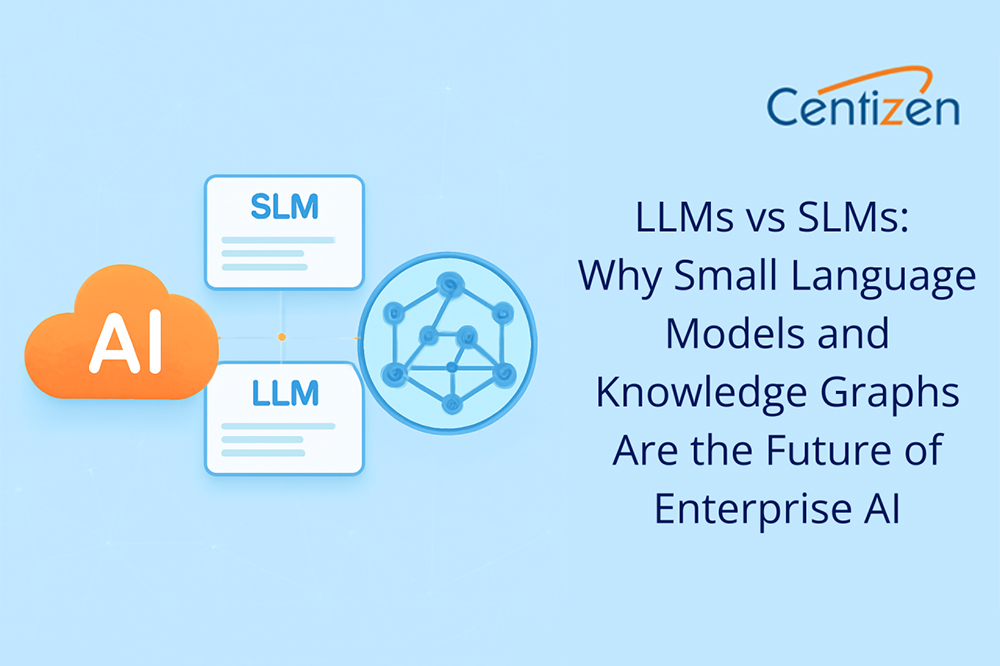LLMs vs SLMs: Why Small Language Models and Knowledge Graphs Are the Future of Enterprise AI

When enterprises think about AI, the spotlight almost always falls on large language models (LLMs). They’re powerful, versatile, and headline-grabbing. But in reality, small language models (SLMs)—combined with knowledge graphs—are emerging as the smarter path forward. Bigger isn’t always better, especially when business problems demand precision, speed, and context.
LLMs vs SLMs: The real difference
Large language models are built for breadth. They’ve been trained on massive, diverse datasets, making them generalists. That’s great for open-ended creativity, but not always for business.
SLMs, on the other hand, are:
- Domain-specific → trained for particular industries like finance, logistics, or healthcare.
- Faster & cheaper → require fewer resources, making them more efficient.
- More accurate in context → avoid knowledge drift by staying narrow and focused.
For example, Microsoft’s Phi-2—a compact model trained on math and code—outperforms much larger LLMs in its domain. Its strength comes not from scale, but from focus.
Why enterprises need SLM thinking
Most enterprise challenges are narrow by nature. You don’t need a model that can write poetry or generate movie scripts. You need one that understands your supply chain, customer churn patterns, or compliance workflows.
That’s why many companies are starting to deploy multiple SLMs, each specialized in an area like finance, operations, or customer service. These models:
- Deliver faster and more relevant results.
- Can be combined through a coordinator LLM or AI agent.
- Reflect how businesses actually work: specialized teams solving specialized problems.
This modular design is efficient, cost-effective, and closer to how humans solve problems—by delegating tasks to the right experts.
The orchestration challenge
The downside of having multiple models is complexity. Enterprises must figure out how to:
- Route tasks to the right model.
- Ensure smooth integration without driving up costs.
- Balance SLMs, LLMs, and classic AI tools within one ecosystem.
The best approach emerging today is hybrid: use a general-purpose LLM for broad tasks, and deploy SLMs where precision matters most.
Knowledge graphs: The missing link
Neither LLMs nor SLMs can succeed without structure. That’s where knowledge graphs come in.
Knowledge graphs provide:
- Context → acting like a domain-specific “textbook” for the AI.
- Accuracy → reducing hallucinations by grounding answers in structured data.
- Accessibility → enabling non-technical teams to query complex data intuitively.
When combined with retrieval-augmented generation (RAG) and GraphRAG, knowledge graphs unlock enterprise-scale insights—turning AI from a “black box” into a trusted decision-making partner.
Toward the future of enterprise AI
The next wave of enterprise AI will not be about one giant model ruling them all. Instead, it will be a layered AI stack made up of:
Knowledge graphs provide:
- Small language models (SLMs) for targeted expertise.
- Large language models (LLMs) for coordination.
- Knowledge graphs for structure and trust.
- Classic AI tools like optimization, search, and statistical models.
This integrated, modular approach is what will drive real business value—shifting focus from hype to practical, measurable results.
Final takeaway
The future of enterprise AI lies in precision, not just power. By combining SLMs with knowledge graphs, businesses can build AI systems that are efficient, reliable, and context-aware.
In other words: LLMs may have sparked the AI revolution, but SLMs and knowledge graphs will define its future.
Our services:
- Staffing: Contract, contract-to-hire, direct hire, remote global hiring, SOW projects, and managed services.
- Remote hiring: Hire full-time IT professionals from our India-based talent network.
- Custom software development: Web/Mobile Development, UI/UX Design, QA & Automation, API Integration, DevOps, and Product Development.
Our products:
- ZenBasket: A customizable ecommerce platform.
- Zenyo payroll: Automated payroll processing for India.
- Zenyo workforce: Streamlined HR and productivity tools.
Services
Send Us Email
contact@centizen.com
Centizen
A Leading Staffing, Custom Software and SaaS Product Development company founded in 2003. We offer a wide range of scalable, innovative IT Staffing and Software Development Solutions.
Call Us
India: +91 63807-80156
USA & Canada: +1 (971) 420-1700
Send Us Email
contact@centizen.com
Centizen
A Leading Staffing, Custom Software and SaaS Product Development company founded in 2003. We offer a wide range of scalable, innovative IT Staffing and Software Development Solutions.
Call Us
India: +91 63807-80156
USA & Canada: +1 (971) 420-1700
Send Us Email
contact@centizen.com






